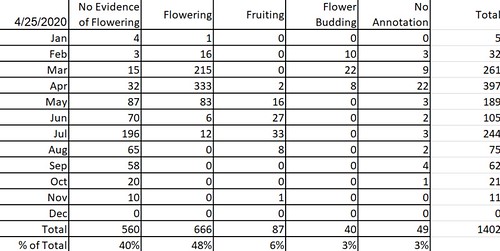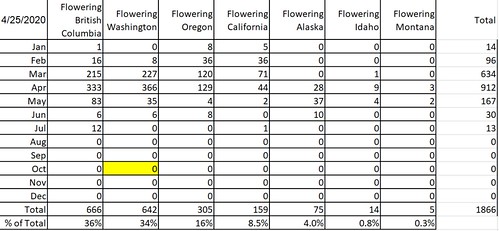When do Western Skunk Cabbage flower?
When my local Western Skunk Cabbage (Lysichiton americanus) flowers, I know that spring is near. I try to observe these plants every year around my town (near Seattle, Washington) and up in the Cascade and Olympic mountains.


On trips to British Columbia and Alaska, I also came across these interesting plants. Since I am spending a lot of time at home due to COVID-19 stay home order, I decided to take a closer look at the flowering time and range of these plants.
Here's was the distribution of the 3500+ observations in North America (25 April 2020):

The majority of the observations occur in coastal regions of British Columbia, Washington State, Oregon, northern California and Alaska. There are also observations in Idaho, Montana and central British Columbia. in this post I'll provide some more quantitative data about the geographic distribution and flowering times. One thing I learned is that preponderance of observations are along the coast but there is a disjunct population in the interior of BC, Idaho and Montana. A future endeavor will be to see what's different about the interior population. (Western Skunk Cabbage has naturalized in Europe but I focused on the North American population where it is native.)
When l started looking at the phenology of Western Skunk Cabbage, I found that the phenology attribute (flowering, flower budding, fruiting, no evidence of flowering, no annotation) was generally not set. The figure below shows a graph of the phenology attributes with the available data for the month of April highlighted on 11 April 2020. There were 887 observations in April; only 101 of these observations had the phenology attribute used. The table indicates that only 6% of the 3425 Western Skunk Cabbage research observations available on 11 April 2020 had the phenology attribute set.


Since I wanted to know more about when Western Skunk Cabbage flowers I decided it was time to get to work. One goal I've had was to spend more time identifying observations for others on iNaturalist and this was a plant I was pretty familiar with. So, it was time to get to work and start looking at several thousand observations. I did this on a month by month basis starting with April and working one month at a time. It was a bit of a slog on occasion and it took me two weeks to get through.
The results are shown in the following figure and table for the 3737 research observations in North America as of 25 April 2020. The flowering peak is in April and the fruiting peak (when the plants are setting seed) is June. The number of observations with no attribute set was reduced from 94% to 5%.
(Please note the color scheme for phenology changed in the two weeks since I started the project, what is annotated below will be consistent for the remainder of this post)
I need to point out many other iNatters have helped with phenology and ID including


My next question was how does the phenology of Western Skunk Cabbage occur over the geographic distribution. An easy filter was to look at the phenology by state or province.Since British Columbia had the most observations, let me start with this province.


I worked my way through British Columbia, Washington State, Oregon, California, Alaska, Montana and Idaho. The results are summarized in this table:

The peak Western Skunk Cabbage flowering month for British Columbia and Washington State is roughly mid-April. Oregon's peak is the beginning of April. California's peak is March and Alaska's peak is May. For Montana and Idaho, the data are sparse; not going to make a conclusion. One other note, there's a yellow box in the October cell of Washington State; one observation is listed as flowering but I excised it as an outlier. I did request the person to reconsider their date of observation.
Here's an analysis of the observations Western Skunk Cabbage fruiting on a month by month basis by state or province:

Observations on iNaturalist are increasing over time. In fact, in the few hours I spent gathering the phenology data by state and province, I could see the number of Western Skunk Cabbage observations increasing for the month of April! The following figure and table provide some insight into Western Skunk Cabbage observations over time on iNaturalist:


In summary, iNaturalist provides some very useful tools that enabled me to have a reasonable look at the phenology of Western Skunk Cabbage (Lysichiton americanus). In order for the tools to work, it's necessary to use the phenology attribute for each observation and for there to be an adequate amount of observations.
Of course, like an other project, there;s always more that can be done. One idea I want to pursue is to download all the data and then use some better estimates of the peaks for areas where there's a lot of data. Also, anecdotally I note that the blooming times for Western Skunk Cabbage are later in the mountains. I'd like to look at that for Mount Rainier and also for disjunct population in the interior of BC, Idaho and Montana. Once I can botanize on a wider scale again, I think I would like to go have a look over in Idaho and interior BC. Also, I have surveyed some local populations of Western Skunk Cabbage within a few kilometers of my house that I want to observe as they proceed to fruit and disperse seed.
I welcome suggestions, ideas, comments and improvements.
Finally, let me thank @hfb and @etantrah who helped with identifying and setting the phenology attributes often. In addition, thanks to all the people who have observed and identified Western Skunk Cabbage including @ajwright @gwark @brucebennett @hchrish200 @mikepatterson @ewrunn1ng @citizen1 @grnleaf @john8 @stewartwechsler @ rambryum @graysquirrel @spacecowboy @brownsbay @johndreynolds @bstarzomski @mrfish33 @katiekushneryk @jasonheadley @northvandad @kathawk @kg-
Also a shout out to @karoopixie for the very useful post https://www.inaturalist.org/journal/karoopixie/21170-adding-photos-to-journal-and-news-posts



Comments
This post is going to be metamorphosing as I inadvertently hit the publish key too soon!
This is an exceptional post and I love the analysis you did (my day job is stats). If you ever made another one of these for another species, tag me. These are the kind of things I hope for my observations to be used for.
Very cool to see this worked up, thanks for sharing! I also work in stats a lot and I love seeing iNat's data worked up and visualized, please let me know what taxa you focus on next and if you need a hand observing/IDing/phenologizing(?)
Wonderful post! Thank you for the kind acknowledgement :-)
I don't have time right now to read it in depth - will do so later.
(A wee notelet: a couple of your images are not showing because you have left out
<imgat the beginning of the tags (beforesrc=).)@spacecowboy @hfb Thanks for your comments and observations and help. I'm a retired electrical engineer; used todo signal processing. I discovered the wonders of biology about 15 year ago. I have been learning a lot. I have thought about analyzing the data by learning the iNat API but that will take more inside work than I care to do right now.
My next idea for a species is likely Saxifraga oppositfolia and I will let you both know. That species interests me because I can find it locally in the Olympic Mountainas at 1800 meters and have also found it at sealevel in Newfoundland. It's circumboreal so it will be fun to look around the world.
@karoopixie Thanks... and I made the corrections. (I should have checked more carefully but my wife called me to dinner....)
No need to apologise - dinner is infinitely more important ;-D
Thank you so much for taking the time and care to complete this analysis. It encourages me to strive to do a better and more complete job of submitting observations. My challenge is to understand definitions of terms so I often don't add them but on this front you have moved the bar higher.
@northvandad Appreciate your excellent observations and kind words. I've received a lot of help from others on iNaturalist, let me know if I can ever help you out.
This is fantastic! Nice work. Now I feel guilty and will definitely tick the correct phenology box! ;)
Add a Comment